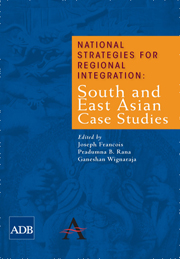9 - Singapore
from East Asian Perspectives
Published online by Cambridge University Press: 05 March 2012
Summary
Introduction: Economic Structure and External Orientation
Singapore's rapid economic development from a modest trading post under British colonial rule into a modern, prosperous, self-confident, and sovereign nation is one of the more notable success stories in growth and development during the second half of the 20th century. The Singapore economy has experienced one of the highest growth rates in the world over the past three decades, its gross domestic product (GDP) growing an annual average 7.6% during 1970-2005. The growth has in turn propelled Singapore's average real per capita income from $512 in 1965 to its current level of over $26,982 by 2005, which is one of the highest in the world (Figure 9.1).
However, long-term averages hide the fact that the Singapore economy has been fairly vulnerable to external shocks over the last 5 years. Specifically, following a sharp downturn in the global electronics industry and the sluggish regional and global growth, Singapore experienced an acute economic contraction in 2001, its worst in 30 years. Its impact on rising rates of redundancies, bankruptcies, financial and asset markets, consumer and business sentiment, and the like, have been deep and widespread. The depth of the recession was largely due to the confluence of a number of negative factors, including the events of 11 September 2001, the bird flu and severe acute respiratory syndrome outbreaks, the December 2004 tsunami, war in the Middle East, shocks to the price of oil, and the dot-com bubble crash.
- Type
- Chapter
- Information
- National Strategies for Regional IntegrationSouth and East Asian Case Studies, pp. 483 - 556Publisher: Anthem PressPrint publication year: 2009



